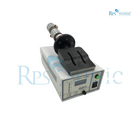
loading
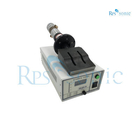

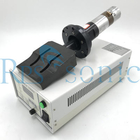

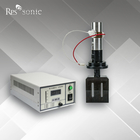

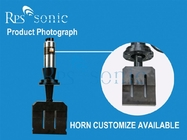

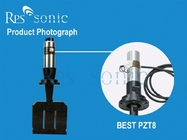

| Place of Origin | China |
|---|---|
| Brand Name | Rps-sonic |
| Certification | CE |
| Model Number | RPS-W20 |
| Minimum Order Quantity | 1pcs |
| Price | negotiable |
| Packaging Details | CARTON |
| Delivery Time | 1DAYS |
| Payment Terms | T/T |
| Supply Ability | 200PCS/MONTH |
| Frequency | 20Khz | Power | 2000w |
|---|---|---|---|
| Horn Material | Titanium,steel,alumium | Horn Size | 110*20mm |
| Weight | 12kg | Application | Mask Earloop Welding |
| High Light | Mask Earloop Ultrasonic Welding Machine,2000w Ultrasonic Welding System,20Khz Ultrasonic Welding System | ||
Parameter
| Item | Parameter |
| Power | 2000W In max |
| Frequency range | ±1khz |
| Operating temperature | ≤65ºC |
| Frequency | 20khz |
| Amplitude adjust | 10%~90% |
| Voltage | 220V |
| Circuit | Digital,separate excitation |
Description
The ultrasonic mask welding machine uses high-frequency vibration waves to be transmitted to the surfaces of two objects to be welded. Under pressure, the surfaces of the two objects are rubbed against each other to form a fusion between molecular layers.
Some indentations can be seen everywhere on the mask, such as the edges, ear straps, and exhalation valve are all ultrasonically welded. As shown in the figure above, in the production process of masks, we can intuitively understand the welding of all-plastic nose bridge, welding after hemming, breathing valve welding, multi-layer seam welding, and ear band welding. These are actually all made by ultrasonic welding. Completed.
When the ultrasonic wave acts on the thermoplastic plastic contact surface, it will produce tens of thousands of high-frequency vibrations per second. This kind of high-frequency vibration with a certain amplitude will transmit the ultrasonic energy to the welding area through the upper weldment. Because the welding area is two The acoustic resistance at the welding interface is large, so local high temperature will be generated. In addition, due to the poor thermal conductivity of the plastic, it cannot be distributed in time for a while, and it gathers in the welding area, which causes the contact surface of the two plastics to melt rapidly, and after a certain pressure is applied, it merges into one.
Ultrasonic welding process
When the ultrasonic stops, let the pressure continue for a few seconds to make it solidify and shape, so that a solid molecular chain is formed to achieve the purpose of welding, and the welding strength can be close to the strength of the raw material. According to different welding methods, ultrasonic welding can be divided into embedded welding, riveting welding, spot welding and forming.
Ultrasonic welding uses 15 kHz-50kHz high frequency vibration to melt and weld plastics. The upper and lower parts are compressed, and the ultrasonic vibration is transmitted to the joints of the upper and lower parts, causing alternating stress at the welding ribs, heating and melting the plastic through the friction between the molecules. The ultrasound stops, and the upper and lower parts continue to be pressed tightly until they are bonded together.
Advantages of ultrasonic welding
Whether it is the use of ultrasonic welding to produce masks and respirators, surgical gowns or various other medical PPE, the advantages over other production methods make it an important technology for non-woven materials to fight COVID 19 and other diseases. These benefits include:
a. Excellent speed and productivity
Ultrasonic welding technology cuts, stitches and bonds nonwovens at extraordinary speeds. In a continuous production line, ultrasonic waves can weld the non-woven fabric layer in less than a second, resulting in a strong and repeatable bond with the base material.
b. Firm and continuous seams and ties. Compared with sewing, the main advantages of ultrasonic technology are that there is no need for sutures, and there is no need to form mechanical holes in the fabric that can contain and hide microorganisms or contaminants to form high strength. High integrity seams and adhesives.
C zero consumables or pollutants
Compared with adhesives, ultrasonic technology eliminates the extra cost of consumables, the extra workload applied, the extra time required for installation and drying, and the risk of exposure to chemical contaminants. Ultrasonic seams can be used after production.
d, high energy efficiency
Ultrasonic technology consumes power only when it is used to cut or bond materials. In addition, since the process immediately generates the required frictional heat through ultrasonic vibration, there is no additional energy consumption or waste associated with preheating and maintaining the hot knife or thermal bonding tool at the required operating temperature.
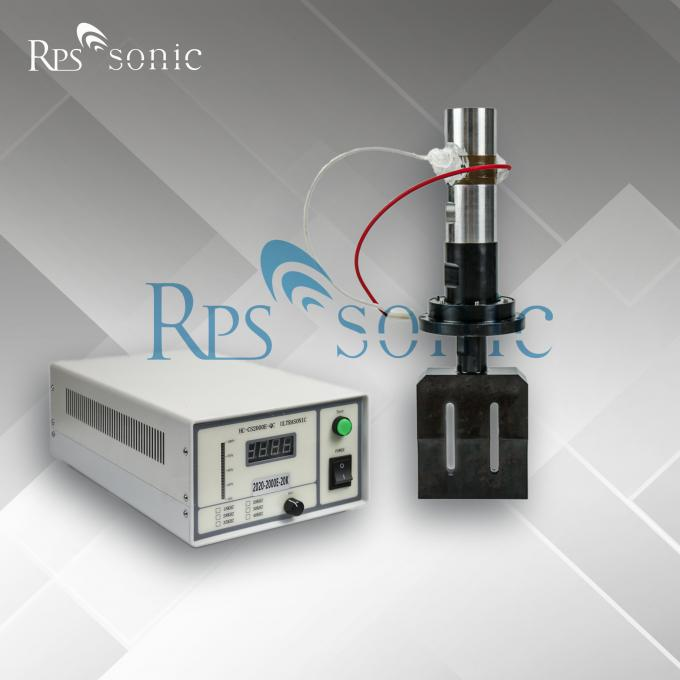
| Frequency | 20Khz | Power | 2000w |
|---|---|---|---|
| Horn Material | Titanium,steel,alumium | Horn Size | 110*20mm |
| Weight | 12kg | Application | Mask Earloop Welding |
| High Light | Mask Earloop Ultrasonic Welding Machine,2000w Ultrasonic Welding System,20Khz Ultrasonic Welding System | ||
Parameter
| Item | Parameter |
| Power | 2000W In max |
| Frequency range | ±1khz |
| Operating temperature | ≤65ºC |
| Frequency | 20khz |
| Amplitude adjust | 10%~90% |
| Voltage | 220V |
| Circuit | Digital,separate excitation |
Description
The ultrasonic mask welding machine uses high-frequency vibration waves to be transmitted to the surfaces of two objects to be welded. Under pressure, the surfaces of the two objects are rubbed against each other to form a fusion between molecular layers.
Some indentations can be seen everywhere on the mask, such as the edges, ear straps, and exhalation valve are all ultrasonically welded. As shown in the figure above, in the production process of masks, we can intuitively understand the welding of all-plastic nose bridge, welding after hemming, breathing valve welding, multi-layer seam welding, and ear band welding. These are actually all made by ultrasonic welding. Completed.
When the ultrasonic wave acts on the thermoplastic plastic contact surface, it will produce tens of thousands of high-frequency vibrations per second. This kind of high-frequency vibration with a certain amplitude will transmit the ultrasonic energy to the welding area through the upper weldment. Because the welding area is two The acoustic resistance at the welding interface is large, so local high temperature will be generated. In addition, due to the poor thermal conductivity of the plastic, it cannot be distributed in time for a while, and it gathers in the welding area, which causes the contact surface of the two plastics to melt rapidly, and after a certain pressure is applied, it merges into one.
Ultrasonic welding process
When the ultrasonic stops, let the pressure continue for a few seconds to make it solidify and shape, so that a solid molecular chain is formed to achieve the purpose of welding, and the welding strength can be close to the strength of the raw material. According to different welding methods, ultrasonic welding can be divided into embedded welding, riveting welding, spot welding and forming.
Ultrasonic welding uses 15 kHz-50kHz high frequency vibration to melt and weld plastics. The upper and lower parts are compressed, and the ultrasonic vibration is transmitted to the joints of the upper and lower parts, causing alternating stress at the welding ribs, heating and melting the plastic through the friction between the molecules. The ultrasound stops, and the upper and lower parts continue to be pressed tightly until they are bonded together.
Advantages of ultrasonic welding
Whether it is the use of ultrasonic welding to produce masks and respirators, surgical gowns or various other medical PPE, the advantages over other production methods make it an important technology for non-woven materials to fight COVID 19 and other diseases. These benefits include:
a. Excellent speed and productivity
Ultrasonic welding technology cuts, stitches and bonds nonwovens at extraordinary speeds. In a continuous production line, ultrasonic waves can weld the non-woven fabric layer in less than a second, resulting in a strong and repeatable bond with the base material.
b. Firm and continuous seams and ties. Compared with sewing, the main advantages of ultrasonic technology are that there is no need for sutures, and there is no need to form mechanical holes in the fabric that can contain and hide microorganisms or contaminants to form high strength. High integrity seams and adhesives.
C zero consumables or pollutants
Compared with adhesives, ultrasonic technology eliminates the extra cost of consumables, the extra workload applied, the extra time required for installation and drying, and the risk of exposure to chemical contaminants. Ultrasonic seams can be used after production.
d, high energy efficiency
Ultrasonic technology consumes power only when it is used to cut or bond materials. In addition, since the process immediately generates the required frictional heat through ultrasonic vibration, there is no additional energy consumption or waste associated with preheating and maintaining the hot knife or thermal bonding tool at the required operating temperature.









Ultrasonic Welding Equipment Ultrasonic Welding Transducer Ultrasonic Welding Converter Ultrasonic Liquid Processor Ultrasonic Cutting Equipment Ultrasonic Spray Nozzles Ultrasonic Power Supply Ultrasonic Soldering Equipment Ultrasonic Welding Horn Ultrasonic Assisted Machining Ultrasonic Testing Equipment
content is empty!